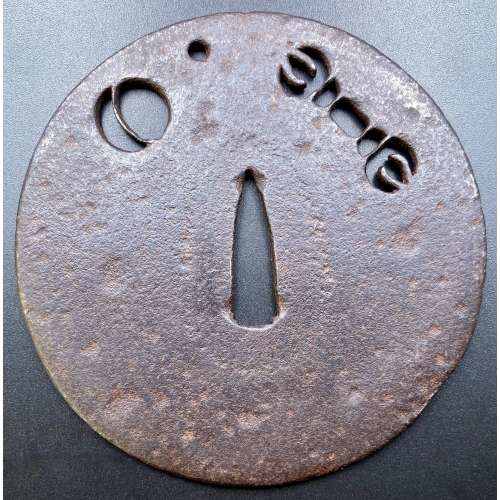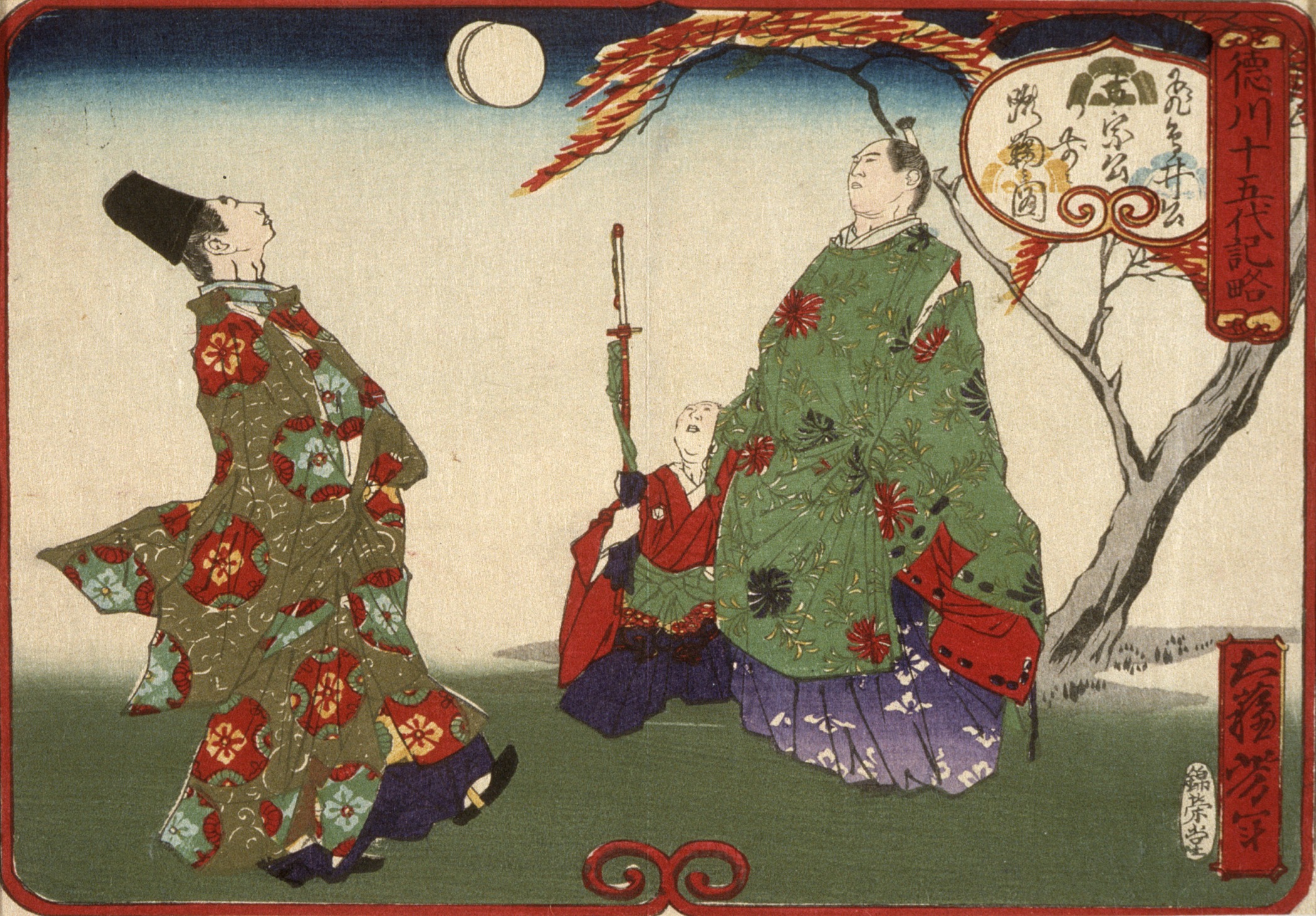-
 Artist: Utagawa Kunisada [歌川 国貞] a.k.a. Utagawa Toyokuni III [三代歌川豊国] (Japanese, 1786 – 1865). Signed: Ōju Toyokuni ga [応需豊国画], in a toshidama cartouche. Double nanushi censor seals: Mera & Murata (1846-50). Publisher: Kojimaya Jūbei [小嶋屋重兵衛] (Japanese, fl. c. 1797 – 1869). A beautiful woman, possibly a kabuki actor Iwai Hanshirō VIII [岩井半四郎] (Iwai Shijaku II, Iwai Kumesaburō III [岩井粂三郎], Iwai Hisajirō II, Japanese, 1829 – 1882), tuning the samisen on a veranda under the shining stars. The complete set of series Moon, Sun, Stars [月日星] (tsuki-hi-hoshi/boshi), three sources of light (sankō) [三光]:
Artist: Utagawa Kunisada [歌川 国貞] a.k.a. Utagawa Toyokuni III [三代歌川豊国] (Japanese, 1786 – 1865). Signed: Ōju Toyokuni ga [応需豊国画], in a toshidama cartouche. Double nanushi censor seals: Mera & Murata (1846-50). Publisher: Kojimaya Jūbei [小嶋屋重兵衛] (Japanese, fl. c. 1797 – 1869). A beautiful woman, possibly a kabuki actor Iwai Hanshirō VIII [岩井半四郎] (Iwai Shijaku II, Iwai Kumesaburō III [岩井粂三郎], Iwai Hisajirō II, Japanese, 1829 – 1882), tuning the samisen on a veranda under the shining stars. The complete set of series Moon, Sun, Stars [月日星] (tsuki-hi-hoshi/boshi), three sources of light (sankō) [三光]: -
 The print lacks signature. It is attributed by some to Suzuki Harunobu and by the others to Isoda Koryūsai.
The print lacks signature. It is attributed by some to Suzuki Harunobu and by the others to Isoda Koryūsai.Attributed to Koryūsai: Pins #517/p.209, c. 1775 [AIC II: Clarence Buckingham Collection, 1925.2772], Ukiyo-e Taisei IV; Vignier & Inada, 1911; Ritsumeikan University Z0165-239.
Attributed to Harunobu: Pins #239/p.132.; BM 1906,1220,0.85;
-
 An uncut fan print shows a young woman holding a basket on a landscape background with hills and pines under a rising sun. Haruo Shirane: "Under the luni-solar calendar, the New Year coincided with the beginning of spring, making it the most important observance of the year for the aristocracy. In the Heian period, New Year ceremonies extended from New Year’s Day (Ganjitsu) to the Day of the Rat (Nenohi), which usually fell on the seventh day of the First Month, when courtiers went out to the fields (no), pulled up small pines, and gathered new herbs (wakana) as a prayer for long life. This ritual gradually spread to the provinces and to commoners, eventually resulting in the New Year practice of the gate pine (kadomatsu), in which a pair of small pines was placed at the gate of a house. A popular Heian-period painting topic representing the First Month was “prayers on the Day of the Rat” (Nenohi no asobi), which depicted the auspicious scene of pulling up small pines in a spring field. Both young herbs and gathering young herbs, particularly at Kasuga Field, became major poetic topics for the First Month, appearing in both the spring and celebration (ga) books of the Kokinshū (Collection of Japanese Poems Old and New, ca. 905). By the Kamakura period, the observance of the Day of the Rat had been abandoned at the imperial court, but the custom of gathering and eating young greens continued as the annual ceremony known as the Seven Grasses (Nanakusa). Note: The Heian-period ritual of pulling up the roots of small pines (komatsu ) on the first Day of the Rat derives from the homonyms ne (rat) and ne (root). Pulling up roots was auspicious, since it implied lengthening the year. The rising sun (hinode) was considered an auspicious sight, particularly at the beginning of the year". [Haruo Shirane, Japan and the Culture of the Four Seasons. Nature, Literature, and the Arts. — Columbia University, NY, 2012]. Title: Gathering of the young herbs on the Day of the Rat [子の日乃若菜] (Nenohi no wakana). Series: Three elegant sources of light [風流三光の内] (fūryū sankō no uchi); meaning the sun, the moon and the stars). Artist: Utagawa Kunisada [歌川 国貞]; a.k.a. Utagawa Toyokuni III [三代歌川豊国] (Japanese, 1786 – 1865). Signed: Toyokuni ga [豊国 画] in a yellow toshidama cartouche. Publisher’s seal: Izuzen (Marks: seal 06-029 | U103b) Date and double nanushi censor seals: Mera and Watanabe, Kaei 6 (1853). A similar theme can be found in Kunisadai's triptych published in about 1844 (HARA SHOBO):
An uncut fan print shows a young woman holding a basket on a landscape background with hills and pines under a rising sun. Haruo Shirane: "Under the luni-solar calendar, the New Year coincided with the beginning of spring, making it the most important observance of the year for the aristocracy. In the Heian period, New Year ceremonies extended from New Year’s Day (Ganjitsu) to the Day of the Rat (Nenohi), which usually fell on the seventh day of the First Month, when courtiers went out to the fields (no), pulled up small pines, and gathered new herbs (wakana) as a prayer for long life. This ritual gradually spread to the provinces and to commoners, eventually resulting in the New Year practice of the gate pine (kadomatsu), in which a pair of small pines was placed at the gate of a house. A popular Heian-period painting topic representing the First Month was “prayers on the Day of the Rat” (Nenohi no asobi), which depicted the auspicious scene of pulling up small pines in a spring field. Both young herbs and gathering young herbs, particularly at Kasuga Field, became major poetic topics for the First Month, appearing in both the spring and celebration (ga) books of the Kokinshū (Collection of Japanese Poems Old and New, ca. 905). By the Kamakura period, the observance of the Day of the Rat had been abandoned at the imperial court, but the custom of gathering and eating young greens continued as the annual ceremony known as the Seven Grasses (Nanakusa). Note: The Heian-period ritual of pulling up the roots of small pines (komatsu ) on the first Day of the Rat derives from the homonyms ne (rat) and ne (root). Pulling up roots was auspicious, since it implied lengthening the year. The rising sun (hinode) was considered an auspicious sight, particularly at the beginning of the year". [Haruo Shirane, Japan and the Culture of the Four Seasons. Nature, Literature, and the Arts. — Columbia University, NY, 2012]. Title: Gathering of the young herbs on the Day of the Rat [子の日乃若菜] (Nenohi no wakana). Series: Three elegant sources of light [風流三光の内] (fūryū sankō no uchi); meaning the sun, the moon and the stars). Artist: Utagawa Kunisada [歌川 国貞]; a.k.a. Utagawa Toyokuni III [三代歌川豊国] (Japanese, 1786 – 1865). Signed: Toyokuni ga [豊国 画] in a yellow toshidama cartouche. Publisher’s seal: Izuzen (Marks: seal 06-029 | U103b) Date and double nanushi censor seals: Mera and Watanabe, Kaei 6 (1853). A similar theme can be found in Kunisadai's triptych published in about 1844 (HARA SHOBO):
豊国三代「豊歳子日若菜摘ノ図」
-
 Artist: Utagawa Kunisada [歌川 国貞] a.k.a. Utagawa Toyokuni III [三代歌川豊国] (Japanese, 1786 – 1865). Signed: Ōju Toyokuni ga [応需豊国画] in a toshidama cartouche. Double nanushi censor seals Mera & Murata (1846-50). Publisher: Kojimaya Jūbei [小嶋屋重兵衛] (Japanese, fl. c. 1797 – 1869). A gentleman, probably a kabuki actor Nakamura Utaemon IV [中村歌右衛門] (Nakamura Shikan II, Nakamura Tsurusuke I, Nakamura Tōtarō, Japanese, 1796 – 1852) drinking tea on a veranda under the shining moon. Series Moon, Sun, Stars [月日星] (tsuki-hi-hoshi/boshi), the three sources of light (sankō) [三光]:
Artist: Utagawa Kunisada [歌川 国貞] a.k.a. Utagawa Toyokuni III [三代歌川豊国] (Japanese, 1786 – 1865). Signed: Ōju Toyokuni ga [応需豊国画] in a toshidama cartouche. Double nanushi censor seals Mera & Murata (1846-50). Publisher: Kojimaya Jūbei [小嶋屋重兵衛] (Japanese, fl. c. 1797 – 1869). A gentleman, probably a kabuki actor Nakamura Utaemon IV [中村歌右衛門] (Nakamura Shikan II, Nakamura Tsurusuke I, Nakamura Tōtarō, Japanese, 1796 – 1852) drinking tea on a veranda under the shining moon. Series Moon, Sun, Stars [月日星] (tsuki-hi-hoshi/boshi), the three sources of light (sankō) [三光]: -
 Artist: Utagawa Kunisada [歌川 国貞] a.k.a. Utagawa Toyokuni III [三代歌川豊国] (Japanese, 1786 – 1865). Signed: Ōju Toyokuni ga [応需豊国画], in a toshidama cartouche. Double nanushi censor seals Mera & Murata (1846-50). Publisher: Kojimaya Jūbei [小嶋屋重兵衛] (Japanese, fl. c. 1797 – 1869). Kabuki actor Ichikawa Danjūrō VIII [市川団十郎] (Ichikawa Ebizō VI, Ichikawa Shinnosuke II, Japanese, 1823 – 1854) watches the sunrise over Mount Fuji. The complete set of series Moon, Sun, Stars [月日星] (tsuki-hi-hoshi/boshi), three sources of light (sankō) [三光]:
Artist: Utagawa Kunisada [歌川 国貞] a.k.a. Utagawa Toyokuni III [三代歌川豊国] (Japanese, 1786 – 1865). Signed: Ōju Toyokuni ga [応需豊国画], in a toshidama cartouche. Double nanushi censor seals Mera & Murata (1846-50). Publisher: Kojimaya Jūbei [小嶋屋重兵衛] (Japanese, fl. c. 1797 – 1869). Kabuki actor Ichikawa Danjūrō VIII [市川団十郎] (Ichikawa Ebizō VI, Ichikawa Shinnosuke II, Japanese, 1823 – 1854) watches the sunrise over Mount Fuji. The complete set of series Moon, Sun, Stars [月日星] (tsuki-hi-hoshi/boshi), three sources of light (sankō) [三光]: -
 A ko-tosho tsuba made of iron, of the round form (丸型, maru-gata), pierced in negative silhouette (文透, mon-sukashi) with the design of Shingon Buddhism symbols of vajra [金剛杵] (kongosho), Sun, Moon and Star [月日星] (tsuki-hi-hoshi) – three sources of light [三光] (sankō). Round rim. No hitsu-ana; the shape of nakago-ana may suggest use on naginata [薙刀. Muromachi period (1393 – 1573). Height: 94.4 mm, Width: 93.4 mm, Centre thickness: 3.1 mm. Another possible explanation for "The element at the 11-o’clock position is in my opinion a kemari ball for the courtly game of the same name (picture attached)" [Markus Sesko].
A ko-tosho tsuba made of iron, of the round form (丸型, maru-gata), pierced in negative silhouette (文透, mon-sukashi) with the design of Shingon Buddhism symbols of vajra [金剛杵] (kongosho), Sun, Moon and Star [月日星] (tsuki-hi-hoshi) – three sources of light [三光] (sankō). Round rim. No hitsu-ana; the shape of nakago-ana may suggest use on naginata [薙刀. Muromachi period (1393 – 1573). Height: 94.4 mm, Width: 93.4 mm, Centre thickness: 3.1 mm. Another possible explanation for "The element at the 11-o’clock position is in my opinion a kemari ball for the courtly game of the same name (picture attached)" [Markus Sesko].
Tsukioka Yoshitoshi [月岡 芳年] (Japan, 1839 – 1892): Tokugawa Yoshimune [徳川 吉宗] (1684 – 1751) playing kemari [蹴鞠]
-

Iron tsuba of round form with one hitsu ana; centre of the plate outlined with the inlaid circular brass wire broke by a circular opening 7 mm in diameter located between 4 and 5 o’clock of the plate and in its turn outlined with brass wire. Extraneous to the central wire, the plate is decorated with four rows of brass dots (ten-zogan). A few dots are missing. In a custom kiri wood box. The meaning of the emblem is probably either the sun or the moon.
Ōnin school. Unsigned.
Mid Muromachi period, middle of the 15th century.
Dimensions: diameter 88 mm; thickness 3.3 mm.





